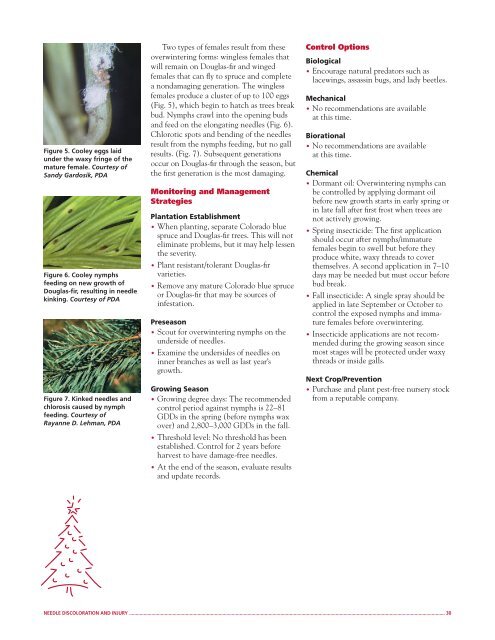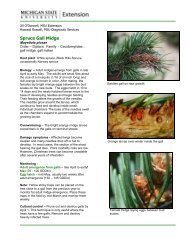Integrated Pest Management for Christmas Tree Production: A ...
Integrated Pest Management for Christmas Tree Production: A ...
Integrated Pest Management for Christmas Tree Production: A ...
You also want an ePaper? Increase the reach of your titles
YUMPU automatically turns print PDFs into web optimized ePapers that Google loves.
Figure 5. Cooley eggs laid<br />
under the waxy fringe of the<br />
mature female. Courtesy of<br />
Sandy Gardosik, PDA<br />
Figure 6. Cooley nymphs<br />
feeding on new growth of<br />
Douglas-fi r, resulting in needle<br />
kinking. Courtesy of PDA<br />
Figure 7. Kinked needles and<br />
chlorosis caused by nymph<br />
feeding. Courtesy of<br />
Rayanne D. Lehman, PDA<br />
Two types of females result from these<br />
overwintering <strong>for</strong>ms: wingless females that<br />
will remain on Douglas-fi r and winged<br />
females that can fl y to spruce and complete<br />
a nondamaging generation. The wingless<br />
females produce a cluster of up to 100 eggs<br />
(Fig. 5), which begin to hatch as trees break<br />
bud. Nymphs crawl into the opening buds<br />
and feed on the elongating needles (Fig. 6).<br />
Chlorotic spots and bending of the needles<br />
result from the nymphs feeding, but no gall<br />
results. (Fig. 7). Subsequent generations<br />
occur on Douglas-fi r through the season, but<br />
the fi rst generation is the most damaging.<br />
Monitoring and <strong>Management</strong><br />
Strategies<br />
Plantation Establishment<br />
• When planting, separate Colorado blue<br />
spruce and Douglas-fi r trees. This will not<br />
eliminate problems, but it may help lessen<br />
the severity.<br />
• Plant resistant/tolerant Douglas-fi r<br />
varieties.<br />
• Remove any mature Colorado blue spruce<br />
or Douglas-fi r that may be sources of<br />
infestation.<br />
Preseason<br />
• Scout <strong>for</strong> overwintering nymphs on the<br />
underside of needles.<br />
• Examine the undersides of needles on<br />
inner branches as well as last year’s<br />
growth.<br />
Growing Season<br />
• Growing degree days: The recommended<br />
control period against nymphs is 22–81<br />
GDDs in the spring (be<strong>for</strong>e nymphs wax<br />
over) and 2,800–3,000 GDDs in the fall.<br />
• Threshold level: No threshold has been<br />
established. Control <strong>for</strong> 2 years be<strong>for</strong>e<br />
harvest to have damage-free needles.<br />
• At the end of the season, evaluate results<br />
and update records.<br />
Control Options<br />
Biological<br />
• Encourage natural predators such as<br />
lacewings, assassin bugs, and lady beetles.<br />
Mechanical<br />
• No recommendations are available<br />
at this time.<br />
Biorational<br />
• No recommendations are available<br />
at this time.<br />
Chemical<br />
• Dormant oil: Overwintering nymphs can<br />
be controlled by applying dormant oil<br />
be<strong>for</strong>e new growth starts in early spring or<br />
in late fall after fi rst frost when trees are<br />
not actively growing.<br />
• Spring insecticide: The fi rst application<br />
should occur after nymphs/immature<br />
females begin to swell but be<strong>for</strong>e they<br />
produce white, waxy threads to cover<br />
themselves. A second application in 7–10<br />
days may be needed but must occur be<strong>for</strong>e<br />
bud break.<br />
• Fall insecticide: A single spray should be<br />
applied in late September or October to<br />
control the exposed nymphs and immature<br />
females be<strong>for</strong>e overwintering.<br />
• Insecticide applications are not recommended<br />
during the growing season since<br />
most stages will be protected under waxy<br />
threads or inside galls.<br />
Next Crop/Prevention<br />
• Purchase and plant pest-free nursery stock<br />
from a reputable company.<br />
NEEDLE DISCOLORATION AND INJURY ................................................................................................................................................................................................................................................ 30





